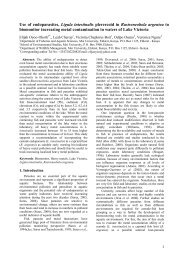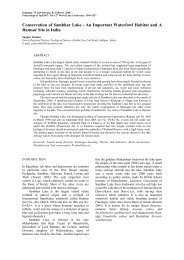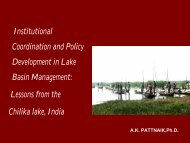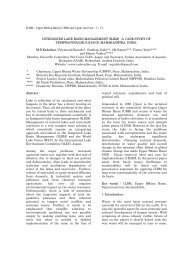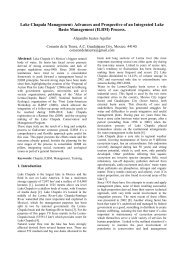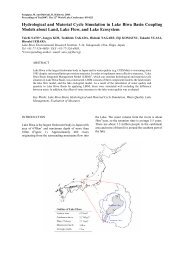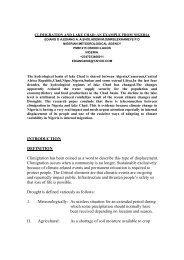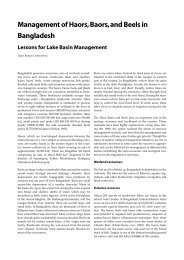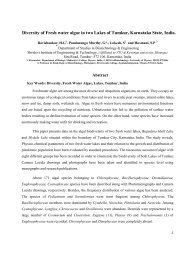Global Promotion of Integrated Lake Basin Management
Global Promotion of Integrated Lake Basin Management
Global Promotion of Integrated Lake Basin Management
Create successful ePaper yourself
Turn your PDF publications into a flip-book with our unique Google optimized e-Paper software.
<strong>Global</strong> <strong>Promotion</strong> <strong>of</strong><br />
<strong>Integrated</strong> <strong>Lake</strong> <strong>Basin</strong><br />
<strong>Management</strong><br />
(ILBM)<br />
- ILEC’s ILEC s Strategy, Challenges and Prospects-<br />
Prospects<br />
Masahisa Nakamura<br />
Chairman ILEC Scientific Committee, and<br />
Pr<strong>of</strong>essor, Shiga University Center for Sustainability and Environment<br />
Environment<br />
Wuhan, China<br />
November 2, 2009
What is<br />
ILBM?<br />
Masahisa Nakamura,<br />
ILEC, May 2009
Let’s look at some<br />
Asian <strong>Lake</strong> <strong>Basin</strong>s<br />
Masahisa Nakamura,<br />
ILEC, May 2009
Bhoj Wetlands<br />
Severe eutrophication<br />
laundry washing<br />
Heavy metal pollution<br />
idol emersion<br />
Water hyacinth<br />
infestation<br />
Sedimentation<br />
agricultural soil erosion<br />
Solid waste pollution<br />
Masahisa Nakamura,<br />
ILEC, May 2009
Eutriphication<br />
Laguna <strong>Lake</strong><br />
• Urbanization/industrization<br />
• Serious catchment<br />
degradation<br />
Sector Conflicts<br />
• Fishery, Agriculture, Water<br />
Supplies, Flood Control<br />
• Operation <strong>of</strong> hydraulic gates<br />
Shoreline Enchroachment<br />
• Political and Jurisdictional<br />
Issues<br />
Masahisa Nakamura,<br />
ILEC, May 2009
Threatend Traditional Life-Style Life Style<br />
Degradation <strong>of</strong> terrestrial<br />
and aquatic ecosystems<br />
• over-exploitation <strong>of</strong> coastal and<br />
in-lake resources<br />
Health threats<br />
• human waste disposal in water<br />
and on land<br />
<strong>Lake</strong> Tonle Sap<br />
Masahisa Nakamura,<br />
ILEC, May 2009
<strong>Lake</strong> Dianchi - Issues<br />
Water scarcity<br />
• Urban and industrial demand<br />
Water quality degradation<br />
<strong>Lake</strong> Dianchi<br />
is facing many<br />
challenges:<br />
• Wastewater discharges<br />
• Diffuse nutrient source<br />
• Industrial pollution<br />
• Severe eutrophication<br />
Environmental and ecological<br />
deterioration<br />
• Reclamation <strong>of</strong> littoral zone<br />
• Soil erosion<br />
• <strong>Lake</strong> siltation<br />
• Fish biodiversity threatened<br />
<strong>Lake</strong> Dianchi<br />
having important<br />
implications to<br />
others lakes in the<br />
world !<br />
Masahisa Nakamura,<br />
ILEC, May 2009
ILBM-Governance ILBM Governance Project<br />
Nepal<br />
Malaysia<br />
India<br />
Russia<br />
Mexico<br />
Philippines<br />
…………….. ……………..
a. Nepalese <strong>Lake</strong>s- <strong>Lake</strong>s Issues<br />
Degrading <strong>Global</strong> Aesthetic and Cultural Assets<br />
Biodiversity loss<br />
Diminishing Livelihood for Ethnic Villagers<br />
Deforestation<br />
Unsustainable agriculture<br />
Soil erosion<br />
Exploitative • 6000 rivers practices<br />
• 3252 Glaciers<br />
Resource Provisions for Downstream Polulation<br />
• > 10 Reservoirs<br />
Centers<br />
• 234 <strong>Lake</strong>s (!)<br />
Increasing • > 23,000 urbanization<br />
Ponds<br />
Increasing • Marshy population lands<br />
• Paddy fields<br />
Tourism development<br />
•5% <strong>of</strong><br />
Nepal’s land<br />
is under<br />
wetlands.<br />
•High Mountain: 182<br />
•Mid Hills: 6<br />
•Terai: 46<br />
Masahisa Nakamura,<br />
ILEC, May 2009
. Malaysian <strong>Lake</strong>s and<br />
Reservoirs<br />
Diminishing Tropical Wetlands<br />
Loss <strong>of</strong> indigenous species<br />
Land Use Change and Its Impacts<br />
Massive soil erosion<br />
Expanding palm oil and rubber estates<br />
Urban and industrial developments<br />
Point and nonpoint source pollutions<br />
Shortage <strong>of</strong> sewerage coverage<br />
Need for nutrient removal<br />
Agricultural chemicals<br />
Masahisa Nakamura,<br />
ILEC, May 2009
a <strong>Global</strong> Pr<strong>of</strong>ile<br />
<strong>of</strong> the State <strong>of</strong> <strong>Lake</strong> <strong>Basin</strong>s<br />
Experience and Lessons Learned<br />
from 28 cases<br />
Masahisa Nakamura,<br />
ILEC, May 2009
<strong>Lake</strong>s in the World<br />
16 Types <strong>of</strong> <strong>Lake</strong> problems<br />
Masahisa Nakamura,<br />
ILEC, May 2009
Why do all <strong>of</strong> the world’s<br />
lakes degrade ?<br />
Masahisa Nakamura,<br />
ILEC, May 2009
Bhoj Wetland<br />
<strong>Lake</strong> Dianchi <strong>Lake</strong> Toba<br />
<strong>Lake</strong>s and <strong>Basin</strong>s<br />
Chilika Lagoon<br />
<strong>Lake</strong> Xinghai/Khanka<br />
T. Ballatore<br />
<strong>Lake</strong> Biwa<br />
Tonle Sap Laguna de Bay
<strong>Lake</strong> <strong>Basin</strong>s<br />
(Watersheds) are Lentic<br />
– Lotic Combinations<br />
Lotic water<br />
system<br />
<strong>Global</strong>ly,<br />
90% <strong>of</strong> Water is<br />
in Lentic form<br />
Natural lentic<br />
water system<br />
Artificial water system
A <strong>Lake</strong> <strong>Basin</strong> consisting <strong>of</strong> Many <strong>Lake</strong> <strong>Basin</strong>s<br />
Microscale<br />
Watershed<br />
Mesoscale<br />
Watershed<br />
Lentic<br />
Waterbodies<br />
Macro-scale Watershed
<strong>Integrated</strong> Water Resources<br />
<strong>Management</strong> (IWRM)<br />
<strong>Integrated</strong> River <strong>Basin</strong><br />
<strong>Management</strong> (IRBM)<br />
But they cannot adequately take into account<br />
90% <strong>of</strong> Earth’s Waters !!!<br />
What are missing ?<br />
Unique Features <strong>of</strong> Lentic<br />
Water behaviors<br />
…….need for ILBM
ILBM Principles:<br />
• “Lentic Water System” Principle<br />
• “Change in Resource Value” Principle<br />
• “Ecological Service” Principle<br />
• “Governance Improvement” Principle
Unique Features <strong>of</strong> <strong>Lake</strong>s<br />
• Integrating Nature<br />
(Everything comes together)<br />
→ 1. Issues are mostly inseparable<br />
• Long Retention Time Retention Time.ppt<br />
(Problems remain long, and<br />
• finding solutions also takes long time)<br />
→ 2. Changes are gradual and invisible<br />
• Complex Response Dynamics<br />
(Everything affects<br />
everything else in water)<br />
→ 3. Unpredictable and Uncontrollable<br />
Masahisa Nakamura,<br />
ILEC, May 2009
Let’s Look at Resouce Values<br />
Resource<br />
Provision<br />
Service<br />
More<br />
Development<br />
Free Access<br />
Development<br />
Efforts<br />
Time<br />
Peak<br />
Conservation<br />
Efforts<br />
Rapid Decline<br />
Don’t Return to Peak<br />
Loss <strong>of</strong> Other<br />
Services also
Ecosystem<br />
Response<br />
What is going on inside the <strong>Lake</strong>?<br />
Development<br />
Efforts<br />
Highly Degraded<br />
Situation<br />
Time<br />
Gradually<br />
Deteriorates<br />
Conservation<br />
Efforts<br />
Recovery<br />
is Slow<br />
Not Recover<br />
Totally
Hysterysis<br />
System won’t fully recover<br />
(or Regime Shift may set in)
ILBM Principles:<br />
• “Lentic Water System” Principle<br />
• “Change in Resource Value” Principle<br />
• “Ecological Service” Principle<br />
• “Governance Improvement” Principle
Ecosystem Services<br />
Resource Provision<br />
Service<br />
Regulating Service<br />
Cultural Service<br />
Supporting<br />
Service<br />
• Water Supplies<br />
• Fish<br />
• Irrigation Crops<br />
• Wood and Fiber<br />
• Fuel<br />
• Hydropower<br />
Potential, etc.<br />
Masahisa Nakamura,<br />
ILEC, May 2009
Ecosystem Services<br />
Resource Provision<br />
Service<br />
Regulating Service<br />
Cultural Service<br />
Supporting<br />
Service<br />
•Indigenous Species<br />
• Flood and Drought<br />
Mitigation Capacity<br />
• Self-purification<br />
Capacity<br />
• Health Provisions<br />
• Navigation Routes<br />
•Productive Riparian Ecosystem<br />
• Climate Mediation<br />
• Aquatic Habitats<br />
• Diverse Food-chains<br />
• Coastal Ecotone<br />
Buffer Capacity<br />
• Fertile Lands<br />
Masahisa Nakamura,<br />
ILEC, May 2009
Ecosystem Services<br />
Resource Provision<br />
Service<br />
Regulating Service<br />
Cultural Service<br />
Supporting<br />
Service<br />
• Aesthetic and Scenic<br />
Values<br />
• Religious Sites and<br />
Spiritual Values<br />
• Historic Sites<br />
• Educational<br />
Resources<br />
Masahisa Nakamura,<br />
ILEC, May 2009
Ecosystem Services<br />
Resource Provision<br />
Service<br />
Regulating Service<br />
Cultural Service<br />
Supporting<br />
Service<br />
• Soil Properties<br />
• Habitat formation<br />
• Primary production<br />
• Nutrient cycling<br />
Masahisa Nakamura,<br />
ILEC, May 2009
Ecosystem Services<br />
Resource Provision<br />
Service<br />
Regulating Service<br />
Cultural Service<br />
Supporting<br />
Service<br />
We all want<br />
this value<br />
We all forget<br />
these<br />
values<br />
Masahisa Nakamura,<br />
ILEC, May 2009
Without Timely Conservation, all<br />
Ecosystem Services may Disappear.<br />
Exploitation <strong>of</strong><br />
Resource Provision<br />
Resource Service<br />
Provision Service<br />
Degradation Loss <strong>of</strong> <strong>of</strong><br />
Regulating<br />
Regulating<br />
Regulating Service<br />
Service<br />
Service<br />
Cultural Service<br />
Supporting<br />
Service<br />
Masahisa Nakamura,<br />
ILEC, May 2009
How Do We Manage<br />
<strong>Lake</strong>s?<br />
We have to know <strong>of</strong><br />
the Unique Features <strong>of</strong> <strong>Lake</strong>s<br />
Masahisa Nakamura,<br />
ILEC, May 2009
ILBM Principles:<br />
• “Lentic Water System” Principle<br />
• “Change in Resource Value” Principle<br />
• “Ecological Service” Principle<br />
• “Governance Improvement” Principle
<strong>Lake</strong> Features lead to<br />
<strong>Management</strong> Requirements, i.e.,<br />
1. Issues are mostly inseparable<br />
2. Changes are gradual and invisible<br />
3. Unpredictable and Uncontrollable<br />
so what do we Need to do?<br />
and what are the Challenges? Challenges?
Let’s Let s look at <strong>Management</strong> Requirement 1.<br />
1. Issues are mostly inseparable<br />
we Need to ….<br />
but the Challenges are:<br />
Over Entire <strong>Basin</strong><br />
• manage Across Jurisdictions<br />
(jurisdictions have competing needs)<br />
• manage Land and Water together<br />
(interactions are <strong>of</strong>ten very complicated)<br />
• introduce Multiple Policies and Programs<br />
(implementation becomes quite complex)<br />
Masahisa Nakamura,<br />
ILEC, May 2009
<strong>Management</strong> Requirement 2.<br />
2. Changes are gradual and invisible<br />
we Need to ….<br />
but the Challenges are:<br />
• have Policy and Financial Commitments<br />
(the political and economic situations may<br />
change over time)<br />
Over LongTime<br />
• have Monitoring and Applied Studies<br />
(politicians may demand quick results with<br />
limited funding)<br />
Masahisa Nakamura,<br />
ILEC, May 2009
<strong>Management</strong> Requirements<br />
3. Unpredictable and Uncontrollable<br />
we Need to …<br />
but the Challenges are<br />
• Understand how People and Nature works<br />
(<strong>of</strong>ten policy application may be limited )<br />
to expand our Mind<br />
• take “Precautionary Approach”<br />
(we overlook early warning, and lament over<br />
late lessons)<br />
Masahisa Nakamura,<br />
ILEC, May 2009
the Challenges<br />
encompass…<br />
Space<br />
People’s<br />
Mind<br />
Time<br />
we need a systematic<br />
approach in:<br />
Heart-ware<br />
S<strong>of</strong>t-ware Hard-ware<br />
Masahisa Nakamura,<br />
ILEC, May 2009
Needs<br />
• Need to management<br />
across jurisdictions<br />
• Need to know air-landwater<br />
linkages<br />
• Need to introduce<br />
multiple policies and<br />
programs<br />
• Need to have longterm<br />
policy and<br />
financial commitments<br />
• Need to have longterm<br />
monitoring<br />
• Need Science<br />
• Need “Precautionary<br />
Approach”<br />
Challenges<br />
• How can a balance be<br />
achieved?<br />
• How can we attain partial<br />
linkages?<br />
• Are there innovative ways to<br />
implement implement them satisfactorily?<br />
• Can we develop innovating<br />
financing schemes?<br />
• Collaborative monitoring may<br />
be possible and useful<br />
• Integrate science in all plans<br />
and programs<br />
• Be watchful <strong>of</strong> early warnings,<br />
but late lessons should not be<br />
ignored<br />
Masahisa Nakamura,<br />
ILEC, May 2009
Question is Governance<br />
Lessons Learned from 28 Cases:<br />
Long-term policy with strong implementation<br />
Sustained financial commitment<br />
Heart-ware<br />
S<strong>of</strong>t-ware Hard-ware<br />
Taking into<br />
Account<br />
Flexible and collaborative institutional arrangements<br />
Important participatory roles roles <strong>of</strong> citizens and the public<br />
Continuous<br />
Focused Everything and long-term scientific efforts<br />
Exploration <strong>of</strong><br />
Well-balanced comes in<br />
mix <strong>of</strong> technologies and Good policies<br />
Practices<br />
Long Complex<br />
with<br />
retention<br />
Dynamics<br />
Masahisa Nakamura,<br />
ILEC, May 2009
<strong>Integrated</strong> <strong>Lake</strong> <strong>Basin</strong> <strong>Management</strong><br />
Masahisa Nakamura,<br />
ILEC, May 2009
ILBM Principles:<br />
• “Ecological Service” Principle<br />
• “Change in Resource Value” Principle<br />
• “Lentic Water System” Principle<br />
• “Governance Improvement” Principle
“Ecological Service” Principle<br />
A) Emphasis should shift from “Resource Provision” to<br />
“Regulating”<br />
We need to work on both.<br />
B) Don’t Lose any more “Regulating Service” In many<br />
cases it is the Livelihood issue.<br />
C) Restoration <strong>of</strong> “Regulating Service” is Quite Challenging<br />
Restoration needs Nature’s Help.
“Change in Resource Value” Principle<br />
A) Resource value degradation can be fast, but<br />
its restoration can take long time.<br />
Lost time is lost money.<br />
B) Resource value degradation is usually<br />
accompanied by invisible environmental<br />
degradation<br />
Preservation make much better sense than<br />
rehabilitation.
“Change in Resource Value” Principle<br />
A) Resource value degradation can be fast, but<br />
its restoration can take long time.<br />
Lost time is lost money.<br />
B) Resource value degradation is usually<br />
accompanied by invisible environmental<br />
degradation<br />
Preservation make much better sense than<br />
rehabilitation.
Lentic Water Framework<br />
A) Watersheds are made up <strong>of</strong><br />
multiple scales <strong>of</strong> “lentic-lotic” water systems<br />
B) Lentic water system are most vulnerable, and<br />
must have a central role in any watershed<br />
management<br />
C) Watershed management requires decision on<br />
appropriate spacial scale (multiple management<br />
units) and temporal scale (adoptive management over<br />
time)
Lentic Water Framework<br />
A) Watersheds are made up <strong>of</strong><br />
multiple scales <strong>of</strong> “lentic-lotic” water systems<br />
B) Lentic water system are most vulnerable, and<br />
must have a central role in any watershed<br />
management<br />
C) Watershed management requires decision on<br />
appropriate spacial scale (multiple management<br />
units) and temporal scale (adoptive management over<br />
time)
Governance Improvement Principle<br />
A) ILBM governance framework may be illustrated<br />
with 6 components, i.e.,<br />
B) ILBM governance framework is important, but<br />
there is no“correct” answers,<br />
C) Time, efforts, and money are necessary, though<br />
not sufficient, for governance improvement, but…
Governance Improvement Principle<br />
A) ILBM governance framework may be illustrated<br />
with 6 components, i.e., Policy, Institution,<br />
Participation, Information and Knowledge,<br />
Technology and Funding<br />
B) ILBM governance framework is important, but<br />
there is no“correct” answers, transfer <strong>of</strong> lessons<br />
learned elsewhere is imperative<br />
C) Long-term and continuous effort in “Governance<br />
Improvement” will eventually pay <strong>of</strong>f
The Major Challenge is:<br />
“<strong>Lake</strong> <strong>Basin</strong> Governance”
Consultative Meetings<br />
and Workshops<br />
Development <strong>of</strong> a<br />
Training Module
<strong>Lake</strong>s globally are facing serious problems<br />
<strong>Lake</strong>s in the World<br />
Masahisa Nakamura,<br />
ILEC, May 2009
Can We?<br />
Yes We Can !<br />
Masahisa Nakamura,<br />
ILEC, May 2009



